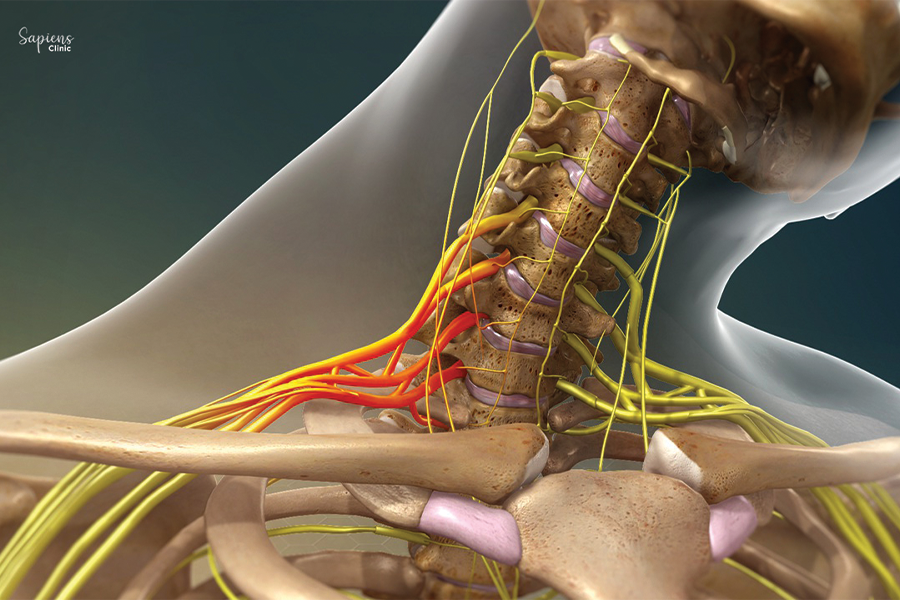Brachial Plexus Injury Treatment in Malleshwaram
Brachial plexus injuries involve damage to the network of nerves transmitting signals from the spinal cord to the shoulder, arm, and hand. At Sapiens Clinic in Malleshwaram, we specialize in diagnosing and treating these complex injuries, aiming to restore function and improve quality of life.
Understanding Brachial Plexus Injuries
The brachial plexus is a bundle of nerves originating from the spinal cord in the neck, extending through the shoulder to the arm and hand. Injuries can occur due to stretching, compression, or tearing of these nerves, leading to varying degrees of motor and sensory deficits.
Causes and Risk Factors
Brachial plexus injuries can result from :
- Trauma: Motor vehicle accidents, falls, or penetrating injuries.
- Birth Complications: Difficult deliveries can cause nerve damage in newborns.
- Sports Injuries: Contact sports may lead to nerve stretching or compression.
- Tumors or Inflammation: Growths or inflammatory conditions affecting nerve function.
Risk factors include high-impact activities, certain medical conditions, and anatomical variations.
Symptoms
Symptoms vary based on injury severity and location:
- Weakness or Paralysis: In the shoulder, arm, or hand.
- Numbness or Tingling: Loss of sensation in the affected limb.
- Pain: Sharp or burning pain in the shoulder or arm.
- Muscle Atrophy: Wasting of muscles due to nerve damage.
Early evaluation is crucial for optimal recovery.
Diagnosis
Accurate diagnosis involves :
- Physical Examination: Assessing muscle strength and sensory function.
- Imaging Studies: MRI or CT scans to visualize nerve damage.
- Electrodiagnostic Tests: EMG and nerve conduction studies to evaluate nerve function.
These assessments help determine the extent and location of the injury.
Treatment Options
Treatment depends on injury severity:
- Non-Surgical Management: Physical therapy and occupational therapy to maintain joint mobility and muscle strength.
- Surgical Interventions:
- Nerve Repair: Reconnecting severed nerves.
- Nerve Grafting: Using donor nerves to bridge gaps.
- Nerve Transfers: Redirecting functional nerves to restore movement.
- Muscle Transfers: Transferring muscles to restore function.
Early surgical intervention may improve outcomes.
Recovery and Rehabilitation
Recovery involves :
- Physical Therapy: Exercises to regain strength and flexibility.
- Occupational Therapy: Training to perform daily activities.
- Pain Management: Medications or therapies to control pain.
- Regular Monitoring: Assessing progress and adjusting treatment plans.
Recovery time varies; some patients may take months to years to regain function.
Conclusion
Brachial plexus injuries can significantly impact daily life, but with timely and appropriate care, recovery is possible. At Sapiens Clinic, Malleshwaram, our multidisciplinary team is dedicated to providing comprehensive treatment plans tailored to each patient’s needs.
FAQs
1. What is the brachial plexus?
A network of nerves that sends signals from the spinal cord to the shoulder, arm, and hand.
2. Can brachial plexus injuries heal on their own?
Minor injuries may recover without intervention, but severe cases often require surgical treatment.
3. How soon should I seek treatment after an injury?
Immediate evaluation is recommended to determine the extent of the injury and initiate appropriate care.
4. What is the success rate of surgical treatments?
Success varies based on injury severity and timing of surgery; early intervention generally yields better outcomes.
5. Are there risks associated with surgery?
As with any surgery, risks include infection, bleeding, and incomplete recovery; however, benefits often outweigh risks in severe cases.

Leave a Reply